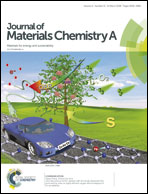Aerosol-spray metal phosphide microspheres with bifunctional electrocatalytic properties for water splitting†
Abstract
Transition metal phosphides have sparked considerable interest as electrocatalysts owing to their excellent catalytic activities towards water splitting. However, the development of a general strategy for the preparation of metal phosphides has remained challenging. In this work, we demonstrate a two-step, aerosol spray-based strategy for the synthesis of various mesoporous monometallic and multimetallic phosphide microspheres. Four monometallic (FeP, CoP, Ni2P, and Cu3P), one bimetallic (Co6Ni4P5) and one trimetallic (Co4Ni3Cu2P10) phosphide samples are successfully prepared, suggesting the generality of our method. In addition, the CoP sample is found to be an excellent material for the hydrogen evolution reaction over a wide pH range through the introduction of corrosion-resistant Cr2O3. On the other hand, its catalytic activity can be switched to the oxygen evolution reaction in combination with Fe2O3. The overpotential for the oxygen evolution reaction to generate a current density of 10 mA cm−2 is as low as 302 mV. This activity can be maintained for at least 50 h. More importantly, a two-electrode electrolyzer constructed from 10% Cr–CoP and 30% Fe–CoP samples delivers a current density of 100 mA cm−2 at a cell voltage of merely 1.67 V, showing the use of these cost-effective materials for bifunctional water splitting.



 Please wait while we load your content...
Please wait while we load your content...